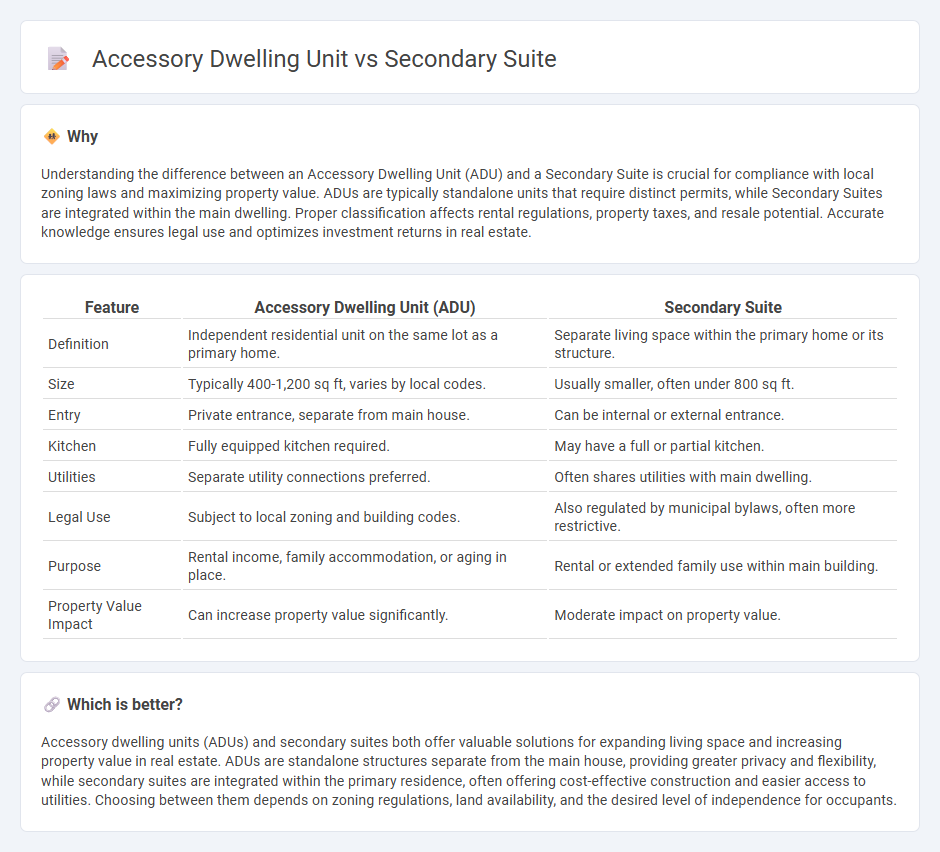
Accessory dwelling units (ADUs) are standalone living spaces separate from the main house, often with their own entrance and kitchen, while secondary suites are self-contained units within the primary residence. Both provide versatile housing options that can increase property value and rental income but differ in structure and regulatory requirements. Explore the distinctions between ADUs and secondary suites to determine the best fit for your real estate investment.
Why it is important
Understanding the difference between an Accessory Dwelling Unit (ADU) and a Secondary Suite is crucial for compliance with local zoning laws and maximizing property value. ADUs are typically standalone units that require distinct permits, while Secondary Suites are integrated within the main dwelling. Proper classification affects rental regulations, property taxes, and resale potential. Accurate knowledge ensures legal use and optimizes investment returns in real estate.
Comparison Table
| Feature | Accessory Dwelling Unit (ADU) | Secondary Suite |
|---|---|---|
| Definition | Independent residential unit on the same lot as a primary home. | Separate living space within the primary home or its structure. |
| Size | Typically 400-1,200 sq ft, varies by local codes. | Usually smaller, often under 800 sq ft. |
| Entry | Private entrance, separate from main house. | Can be internal or external entrance. |
| Kitchen | Fully equipped kitchen required. | May have a full or partial kitchen. |
| Utilities | Separate utility connections preferred. | Often shares utilities with main dwelling. |
| Legal Use | Subject to local zoning and building codes. | Also regulated by municipal bylaws, often more restrictive. |
| Purpose | Rental income, family accommodation, or aging in place. | Rental or extended family use within main building. |
| Property Value Impact | Can increase property value significantly. | Moderate impact on property value. |
Which is better?
Accessory dwelling units (ADUs) and secondary suites both offer valuable solutions for expanding living space and increasing property value in real estate. ADUs are standalone structures separate from the main house, providing greater privacy and flexibility, while secondary suites are integrated within the primary residence, often offering cost-effective construction and easier access to utilities. Choosing between them depends on zoning regulations, land availability, and the desired level of independence for occupants.
Connection
Accessory dwelling units (ADUs) and secondary suites both serve as auxiliary housing structures on the same property as the primary residence, offering additional living space with separate entrances and essential amenities like kitchens and bathrooms. These units increase property value and provide flexible housing options for multigenerational families, rental income, or affordable housing solutions in urban areas. Local zoning laws and building codes often regulate the development of ADUs and secondary suites to ensure safety, privacy, and neighborhood compatibility.
Key Terms
Zoning
Secondary suites and accessory dwelling units (ADUs) differ primarily in zoning regulations that dictate their size, location, and allowable use on residential properties. Zoning codes often restrict secondary suites to internal modifications within a single-family home, whereas ADUs can be detached structures or converted spaces meeting specific municipal guidelines. Explore local zoning laws to understand how each option can enhance property value while complying with legal requirements.
Occupancy
Secondary suites typically allow occupancy by family members or long-term tenants, with local zoning laws often limiting the number of occupants based on bedroom count. Accessory dwelling units (ADUs) offer more flexible occupancy arrangements, sometimes permitting short-term rentals depending on municipal regulations. Explore detailed occupancy rules and how they impact your property's usage.
Permitting
Permitting requirements for secondary suites and accessory dwelling units (ADUs) vary significantly based on local zoning laws and building codes, with many municipalities enforcing distinct regulations for each to address safety, occupancy, and land use. Secondary suites are often internal modifications within existing homes requiring specific permits related to fire safety and egress, while ADUs are typically separate structures needing more comprehensive approvals covering site development and utilities. Explore detailed permitting procedures to ensure compliance and smooth authorization for your project.
Source and External Links
Secondary suite - Wikipedia - A secondary suite, also known as accessory dwelling unit or granny flat, is a self-contained residential unit on the same property as a main house, often used for extra income, family support, or security.
Secondary suites and backyard suites - The City of Calgary - A secondary suite is a self-contained residence with separate kitchen, bathroom, living and sleeping facilities, and its own private entrance, designed for independent living on a property with a main dwelling.
The Ultimate Guide to House Plans with Secondary Suites - Secondary suites provide privacy and independence with separate entrances and facilities, and are often designed for accessibility and integration with the main home for family support while maintaining autonomy.
 dowidth.com
dowidth.com